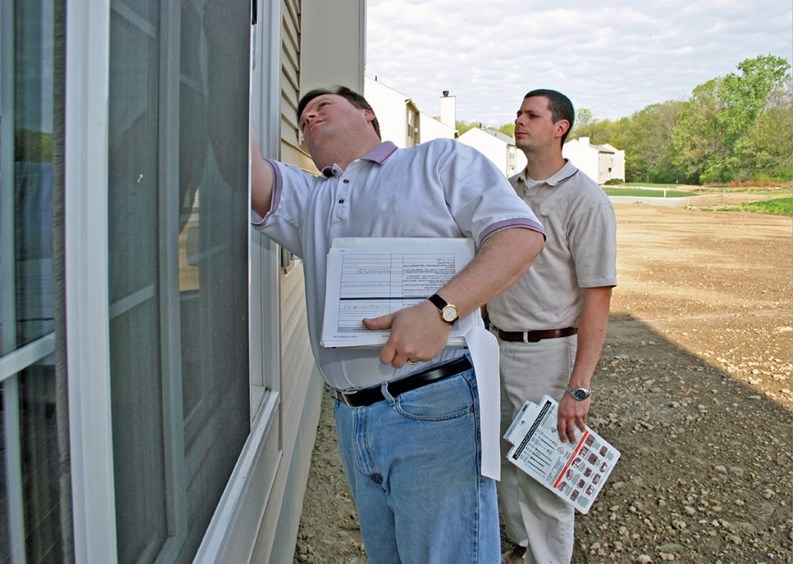Warmer temperatures mean a farewell to clunky boots and bulky coats, but it also means it's time for your building or HOA to shake off the snow and ice and take stock of any damage or wear-and-tear inflicted by the winter months.
Harsh weather and lack of regular maintenance during the winter can take a toll on nearly every aspect of an HOA’s buildings and grounds. Unfortunately, raking a few flowerbeds of old leaves and power washing the siding may be the least of your worries come spring. Long winters generally bring about a plethora of water-induced damage. This damage is best evaluated by the association, board or property manager during a seasonal walk-through—a time for HOA administrators to assess exactly what’s gone on during the harsh winter and formulate a game plan to deal with maintenance issues of both immediate and long-term priority.
Who Should Do the Walk-Through?
There is no stealth team of owners, board members or landscape committee members necessary to examine a property—but it is important that the property manager and at least two board members participate in the primary seasonal walk-through. The more sets of eyes—and a clear understanding board members have of their own property—the better for the HOA as a whole.
"Hopefully if you're hiring a good property management company, they'll be the vehicle to get everybody out there,” says Rob Hastings, vice president of operations for MAMCO Property Management in Mt. Laurel. "When we go through our properties, I generally like to get at least one board member to come along."
“Usually the manager and the vendor who did the snow removal walk the site first for any snow removal damage,” adds Robert Teeling, an executive director for the Northern New Jersey region of Wentworth Property Management. “Then the manager and if a board member wants to walk the site for other damages. If there is a grounds committee, they sometimes do it as well.”
"When we do the inspections, we generally identify the safety-related items first," Hastings continues. "And then property damage second. If there is property damage, we'll contact the insurance company if necessary. If not, we'll go out and entertain at least two to three bids. We get this stuff taken care of as soon as we can in the early spring and move on from there."
Another important factor is that the information during the walk-through is communicated and reported back to the entire board for review. Using modern technology, such as digital photography, you can actively convey what needs to be fixed through images.
Looking Up
So, where to start? Well, begin by looking up.
"We generally look for snow damage," says Hastings. "From the ground, we'll visually check out the roofs and landscaping plant damage, and then plow damage from when they go through the parking lots and they flip up the wheel stops. We'll look for potholes and anything safety related."
It's also vital to assess the property’s trees for potentially hazardous situations. Winter weather can snap tree limbs, and pruning them is not only best for your safety, but also the health of the tree itself and the aesthetic of the overall properly. “This helps promote better air circulation around buildings, preventing moisture issues,” says Matthew T. Gramer, president of NatureWorks Landscape Services, Inc. in Walpole, Massachusetts. “It also deters pests like squirrels from being able to jump onto roofs as easily.”
Looking down, review any damage that may have been caused by winter maintenance vehicles (i.e. plows, sanding trucks, etc.), specifically on lawn areas. When looking at the lawn, take some time to focus on the flowerbeds and quality of mulch left after the harsh season. Generally mulch is laid down each year, and ends up accumulating in certain areas more than others. Excess buildup of mulch can stress other shrubs and trees in the area, as well as cause rotting in the woodwork near the foundation of your home.
Another item to take a close look at is pavement and ornamental stone. Just because something is made of rock or concrete doesn't mean it's impervious to the elements.
"It is a great idea to have the manager and the contractor to get together," says Jason Sponzili of Sponzili Landscape Group Inc., located in Fairfield, "and spend the necessary time walking the site. I would recommend making a checklist of different items, including any types of black copper; concrete items such as Belgian block or curbing, cement parking dividers that might have been disturbed or destroyed. Take a look at your light poles, your garage doors, and your building facades—things like that."
Drainage
Gutters and pipes are another area worth checking out. Make sure to review the property’s drains to ensure they are not clogged with winter debris, specifically before spring rains move in. (And check out our Gutter Maintenance article on Page 16)
It's important to examine your irrigation systems as well, starting with your sprinklers, which will require some standard maintenance as the temperature rises, says Gaetano Virone, president/CEO of Environmental Designers Irrigation in Howell. He recommends turning the water on by zones on the property, and examine each area individually. The sprinkler heads generally need an adjustment—and if they have been blocked by plants and other winter debris, this would be the time to clean out the area.
"We generally get started as soon as the weather breaks in March and are completely finished checking and logging any damage by the end of April," says Virone. "The majority of the damage that we find after a cold winter can be traced to plowing and snow removal activities, the soil settling and shifting, and the cold temperatures that make some of the sprinkler head and valves components fail. The plowing and snow removal damage is easy to imagine."
Once that's done, "The next step is to make the repairs," says Virone, "but that's not always as easy as it sounds. As part of our service we have to manage the budget that’s been adopted for the irrigation system maintenance. We regularly meet with the property manager and the board of trustees to discuss the severity and quantity of the repairs and how they fit into the planned budget."
Proactive Preparation
Fortunately, there are ways to mitigate routine winter damage. The best way to minimize the effects of winter weather is to prepare far in advance. For example, if you’re well aware that the siding will need painting every three years after a hard winter, take that into account as your board hammers out its budget, and work with your management company to bid out the job as early as possible to avoid delays and other hassles of having to rush.
According to Alan Milstein of Live Oak Landscaping Contractors in Piscataway, "With both new and old clients, the first thing we address is whether we're working towards some type of long-term plan. All these communities do reserve studies for their capital expenditures, but we like to direct our clients through what's called a Green Reserve or Landscape Reserve Study as well. That outlines all the long-term needs because over time—things are going to change, things are going to decline or things are going to grow too large for their area and will need to be shaped or moved. We ask a lot of questions."
Answering those types of questions also enables HOA administrators to communicate with their residents about what various costs will mean, and lay everything else out on the table.
And what about priorities? While cracking on pavement may be an eyesore, it takes a back seat to anything that may compromise the foundations of the residential area. Often, some temporary repairs may have been made during the winter and now need permanent fixes, says Elaine Warga-Murray, chief executive officer and managing partner of Regency Management Group, LLC in Howell. Big projects, like siding or roofing repair, are a first priority that should be tackled as soon as a problem is detected.
"For large projects, specifications should be prepared, noting what has to be repaired or replaced and how the repair/replacement is to be implemented," says Warga-Murray. "Smaller repairs, such as mailbox replacements, straightening signs and so forth can be assigned to on-site personnel or maintenance contractors."
The board members will then have to evaluate how much money they have to work with and see what is realistic, and can also elect to get other quotes on projects to ensure they are competitive and that they are diligent in representing the other residents of the association.
Where’s the Funding?
Generally, the maintenance fee is the source of seasonal funding. However, if there are unexpected issues, boards may be asking their residents for an additional sum, usually in the form of a special assessment.
"If the budget isn't sufficient to cover a very bad winter and a series of more than four or five big storms," says Warga-Murray, "either a special assessment must be initiated, or with better planning, the previous years' surplus and/or deferred maintenance funds can be used for repairs. Most managers recommend a deferred maintenance or repair account for snow or unusual storms like blizzards or hurricanes."
Asking for more money is never easy. And unfortunately, these costs may be a bit of a shocker to residents who thought that condo ownership was always going to be easier and cheaper than single-family home ownership. And for the most part, it is—but sometimes things do come up, and the best way to determine those items and get them handled in a timely fashion is to spot them early. And how do you accomplish that? By a seasonal walk-through, of course.
Emily Abbate is a freelance writer and a frequent contributor to The New Jersey Cooperator.







Leave a Comment